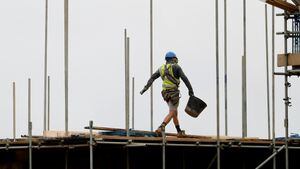Deputy questions idea that GP11 has stifled house-building
Twenty years of house-building data – newly presented by a deputy – has called into question claims that private house-building has been wrecked by the introduction of GP11.

Andrew Taylor has collected figures which show that the slump in developments of more than 20 units – the size affected by GP11 – started years before the introduction of the controversial planning policy in 2016, which requires private developers to build social housing on big projects.
In the years between 2003 and 2009, permission was granted for 226 private homes on larger developments – an average of only about 30 a year – and all were built.
In the seven years immediately before GP11 was introduced, between 2010 and 2016, permission was granted for 556 private homes on larger developments, but only 109 units were built.
‘The data certainly shows that the development of large sites of over 20 units stagnated considerably before GP11 became a consideration, so it’s quite reasonable to conclude that there are other factors at play,’ said Deputy Taylor, vice-president of the Development & Planning Authority.
‘I don’t yet know the reasons for the reduction in house building during the years preceding the introduction of GP11, but it seems reasonable that some of those reasons might remain valid today.
‘As a single data set, I don’t think it would be appropriate to draw any concrete conclusions, although I think it’s reasonable to conclude that the data undermines the assertion that GP11 is the root cause of large developments coming forward.’
Even excluding the high-profile proposed development of Leale’s Yard, developers failed to build about 25% of new homes on larger developments for which they obtained permission between 2010 and 2016.
Since the introduction of GP11, no larger developments have been completed. Some developers and politicians have blamed the policy for the lack of supply of private housing. At this week’s States meeting, deputies will debate various proposals to scrap or suspend it.
Deputy Taylor said the data he had collected indicated that opponents of GP11 were exaggerating its influence.
‘We are about to embark on a debate with potentially significant social and financial impacts for Guernsey which, so far, has been based on hearsay evidence,’ said Deputy Taylor.
‘I have found it staggering how little data has been provided by those seeking to scrap GP11. Personally, I don’t think it is sufficient for a developer simply to say “it doesn’t work” without showing any working out.’
The DPA can set aside GP11 where the requirement to include social housing would make a development unviable.
Deputy Taylor revealed that was done on two proposed developments recently, but he claimed that in both cases the project was unviable even without the requirements of GP11.
‘This quite clearly shows that GP11 is not the current reason for those large sites not progressing,’ he said.
‘If large sites were not progressing before GP11, and they are not progressing now, it is reasonable to conclude that GP11 is not to blame.’
The data was extracted from States housing monitoring reports and other historic records.
‘It is reasonable to say the data was available, but I don’t think it has ever been considered by colleagues in this format,’ said Deputy Taylor.





